Nguyen Van Yen, Member of VNPT Board of Directors
Summary:
-Data and AI in telecommunications: Carriers have a large amount of data that is not being properly utilized. AI can help transform data into tools to improve services and optimize business operations.
- AI application trends: The development of 5G and IoT has pushed carriers to focus on AI since 2016. Recently, GenAI has emerged as a strategic tool, especially after the launch of OpenAI's ChatGPT.
- Economic benefits from AI: AI is predicted to create huge value for carriers, including cutting costs and creating new revenue streams. McKinsey estimates that GenAI could bring $100 billion to the telecommunications industry.
- AI applications in the organization: AI needs to be applied at all levels of the organization, from data analytics to administrative functions. Many carriers have established dedicated AI units and built AI centers of excellence.
- Risks in AI application: Challenges in recruiting AI human resources, managing data and ensuring safety in AI deployment are issues that network operators face. AI governance is an important factor to ensure successful and sustainable deployment.
- Preparing data for AI: To effectively apply AI, operators need to prepare clean, consistent data and ensure a common data model. Data collection and processing is a major challenge, requiring large investments in data analysis and management.
The state of AI applications for telco
The rise of 5G, IoT and the growing volume of Big Data are the factors that are driving telecom service providers to turn their attention to AI. Some of the large, ambitious operators started adopting AI in 2016, 2017 and by 2019 - 2020, the telecom sector has recorded strong adoption of AI in operators around the world . In the last 12 - 15 months (since the launch of OpenAI with Chat GPT), the awareness of GenAI has expanded from an AI-based content creation tool to a strategic platform and is quickly becoming the center of thinking for almost every telecom service provider around the world.
Allied market research report [6] on AI in the telecommunications market in 2022 shows: “The global AI in telecommunications market size is valued at USD 1.2 billion in 2021 and is expected to reach USD 38.8 billion by 2031, growing at a CAGR of 41.4% from 2022 to 2031”. Telecommunication companies (telcos) are turning to AI as a key enabler for innovation, operational efficiency, and enhanced customer experience.

Ericsson believes [1], AI will bring unprecedented value to industries including telecommunications. For network operators, AI will bring opportunities to optimize network operations, improve customer experience, reduce costs, contribute to sustainable development, create new revenue streams, etc.
Gartner [2] conducted a survey and classified 29 AI-related technologies into 5 groups: AI core technology, GenAI-based technology; Data-centric AI technology; AI Trust technology. The trend of deploying GenAI-based technologies is forecasted to increase sharply in the next 1-3 years.
Telcos see GenAI as a turning point, a powerful driver to help drive revenue growth, save costs, and fundamentally change the user experience landscape. Many operators see GenAI as a key focus in their AI strategy.
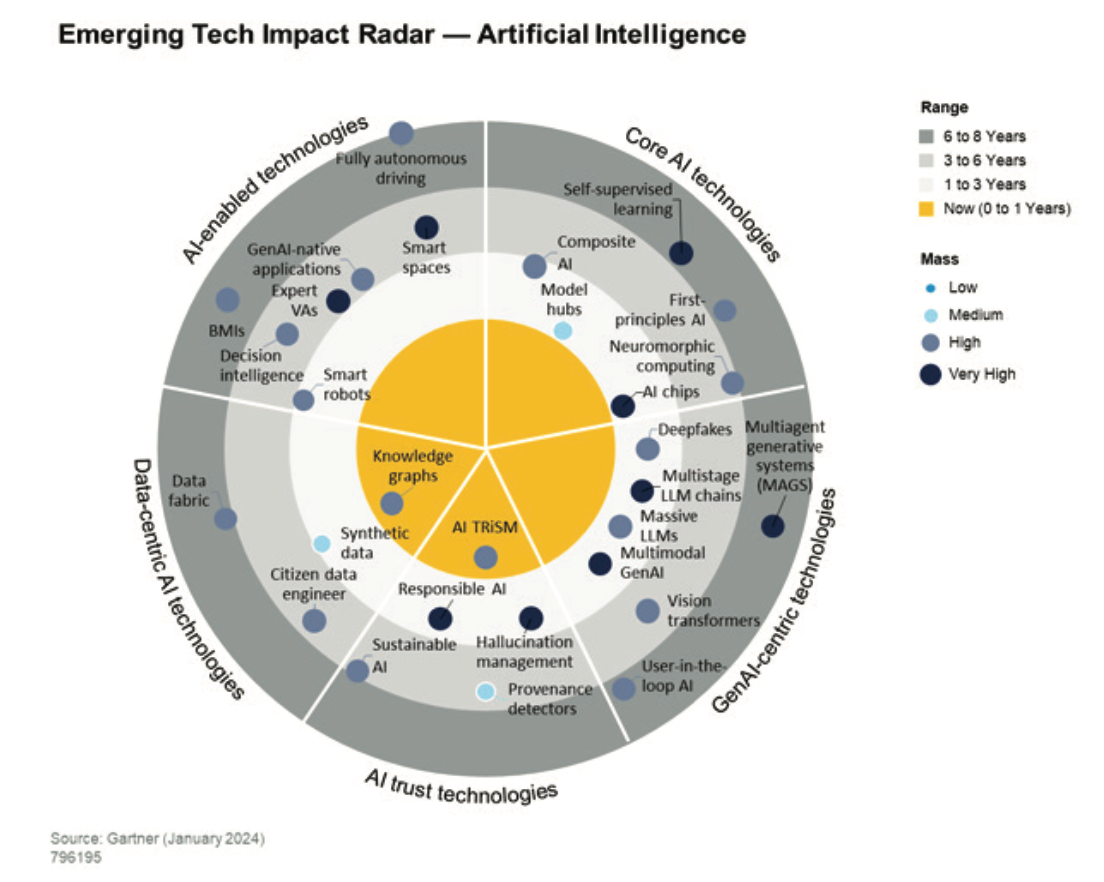
Measuring the economic impact of AI/GenAI
Measuring the economic impact of AI on the telecommunications industry is not an easy task as the potential use cases are broad and diverse and market value estimates vary widely from different sources. However, many operators agree that the benefits of AI to Telco business are significant. For example [4]:
- Labor and job cuts due to AI and automation. BT (UK) estimates that it could cut 10,000 jobs by 2030 by leveraging digitization and automation.
- Generate new revenue by launching AI-enabled products. SK Telecom (South Korea) believes it can generate AI-related revenue of up to 25,000 billion KRW (about 18.5 billion USD) by 2028.
- Help save costs or increase revenue. McKinsey estimates that GenAI could create up to $100 billion in added value for the telecommunications sector.
Operators measure the benefits of each AI use case based on two aspects: Financial (quantifiable time savings, cost savings, increased revenue) and non-financial (employee satisfaction, customer satisfaction, small and difficult-to-quantify time savings, sustainability)
Where is AI applied in telco and how to implement AI
Carriers consider AI a strategic priority to be applied to tasks and departments related to data analysis. However, the recent explosion of GenAI has raised some perspectives on the application of AI in Telco in particular as follows:
- AI application areas in telco:
- AI is an innovative tool, so AI needs to be available to every task force in the company.
+ Every effort must be made to make AI easy to use, even for groups with low technological capabilities.
+ AI-dedicated units need to be able to know the implementation practices of successful AI usecases and build appropriate models and methods for re-applying these usecases throughout the organization.
+ Democratizing access to AI needs to be accompanied by implementing new FinOps approaches for AI to manage the cost risks of AI adoption
+ An AI governance program needs to be developed and implemented to reduce the risk of uncontrolled costs and encourage the use and experimentation of AI.
- AI Deployment in Telco
Build a CXO AI position with expertise and authority to drive AI product and service development and application (e.g. Steve Jarrett appointed Chief AI Officers (CAIOs) Orange Innovation, 12/2023; Deepika Adusumilli, 10/2023 at BT; Chung Suk- guen at SK Telecom).
Establishing a subsidiary to develop AI , for example Proximus Ada is a subsidiary of the network operator Proximus (Belgium) that specifically focuses on developing cybersecurity and AI capabilities to serve Proximus' internal requirements and provide services to B2B customers.
Separate internal AI and customer-facing AI functions. Instead of building a centralized AI organization, Telefónica decided to split it into two divisions: Customer Insights and Innovation; Networks, IT Systems, and Internal Digital Transformation (CDS) towards AI.
This division of responsibilities is particularly interesting as GenAI’s focus is more customer-facing than network functions, while predictive AI is increasingly the technology used for network automation purposes.
AI as a new business function. For example, China Mobile and SK Telecom are investing heavily in AI to deliver new products and services. The focus of both carriers is to build their own Large Language Model (LLM) with the best solutions and features, and sell access to enterprises (DNs) and other carriers.
Establishment of AI Center of Excellence (CoE).
In a TMFrum (2023) survey [4], 53% of carriers said they had established an AI CoE. But the exact size, scope, and role of an AI CoE varies significantly. For example, Vodafone Ziggo (Netherlands) has an AI CoE that brings together the company’s data science experts.
Telefónica has a global AI CoE, led by the Networks and IT division, which specializes in data and AI architecture to serve the goal of transitioning to a common data model and researching AI technologies and solutions.
e& (Middle East) has a CoE where each key department/function has a representative, AI governance is at the forefront with the mission to ensure that successful AI use cases are researched and applied across different departments.
AI as a platform function. Some carriers have built — or are building — AI platforms designed to make it accessible to different parts of the organization.
For example, Vodafone has an AI platform that also provides self-service tools and training materials for different teams to build their own use cases. SK Telecom has an Intelligence Platform that gives the entire organization access to the LLM that SKT is developing.
- AI Management
AI Governance Requirements. Many governance requirements for AI are part of existing data governance programs. However, additional AI-specific safeguards are needed to ensure that AI tools and systems remain safe and ethical. There are two types of AI governance programs:
- The external governance program is designed to protect individuals and organizations outside the company.
- Internal governance programs are designed to protect employees and ensure that AI is deployed successfully and sustainably across the enterprise.
Governance programs aimed at protecting people and organizations outside the company tend to be codified and normative. For example, the European Union (EU) passed the AI Act in December 2023, which will take effect in 2025, and the US issued an Executive Order on AI in October 2023.
Tight government regulations can help Telcos develop technologies and capabilities that can be monetized abroad, especially in countries with strict data sovereignty regulations.
For example, China Mobile believes that the methods it uses to meet AI laws can help develop security technologies that it can offer to its customers. Swisscom is experimenting with building its own AI infrastructure and developing internal expertise that it can use to create value and new solutions in its IT services business.
The emergence of GenAI is also driving the need to improve internal AI governance: Drive scale; Manage costs; Protect the organization from the consequences of using inaccurate results; Reduce the risk of technical debt; Guard against the risk of “corrupt” LLM training model data; Protect the organization from intellectual property (IP)/copyright infringement.
Risks of applying AI in business
TMforum 2023 survey on risks when applying GenAI in Telco includes:
3.1. Human resources for AI
When it comes to hiring AI talent, most telcos are at a disadvantage compared to tech companies, especially when hiring younger talent. Tech companies typically offer better salaries, faster career progression, and a significantly more flexible corporate culture.
TM Forum's survey on Telco human resource needs by specialty [4] shows that AI/machine learning, data analytics and automation skills are in high demand (64%, less than Security at 69%).
In terms of the difficulty of skills that Telcos can recruit, 59% of respondents said that data science/data analytics professionals and AI/ML professionals are the most difficult to recruit (second only to security at 63%).
At MWC 2024, Korea Telecom (Korea) announced that it will recruit up to 1,000 AI and digital experts this year in an effort to become an AICT - AI and ICT company. At the same time, KT also increased internal training in AI skills to completely change KT's DNA towards AI.
China Mobile established Jiutian in 2019 as a platform to support its ambition to become a highly automated carrier by 2025. The AI platform is accessible to external developers through open APIs. In October 2023, China Mobile developed its own LLM as part of Jiutian. Starting with just 20 AI engineers, China Mobile now has 600 AI engineers and plans to reach 1,000 by the end of 2024.
Vodafone is partnering with hyperscalers for its AI platform, but still needs AIOps skills as well as analytics, automation, cloud and platforms. Vodafone is attracting talent by hiring full-time.
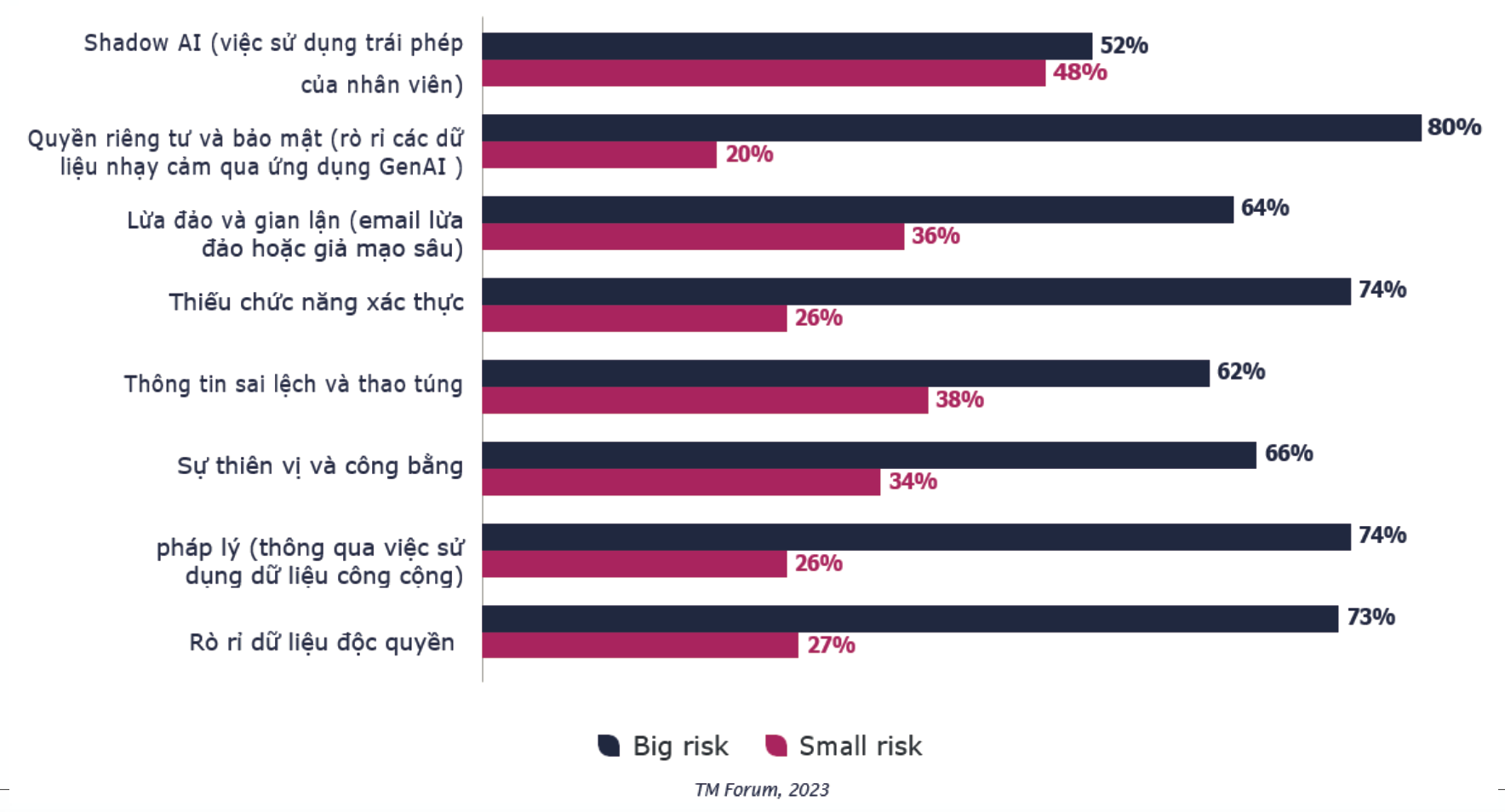
Ashish Yadav, Senior Director at Capgemini, said that Telcos are increasingly looking for senior Cloud and AI talent at the architect level through system integration companies as a form of Insourcing. The definition of insourcing can be interpreted in many different ways, but in this context, Telcos “treat” the senior talent of the partner company as a member of the Telco’s working team.
Most telecom companies are also ramping up retraining and upskilling to proactively source AI talent on demand. In fact, this approach can be more cost-effective than hiring new talent, and is increasingly being applied to all other hard-to-hire skills.
In a TMForum survey on what carriers need to do to effectively leverage AI and machine learning, 60% of respondents said training existing employees in multiple AI skills would have a high impact, while 39% said it would have a significant impact.
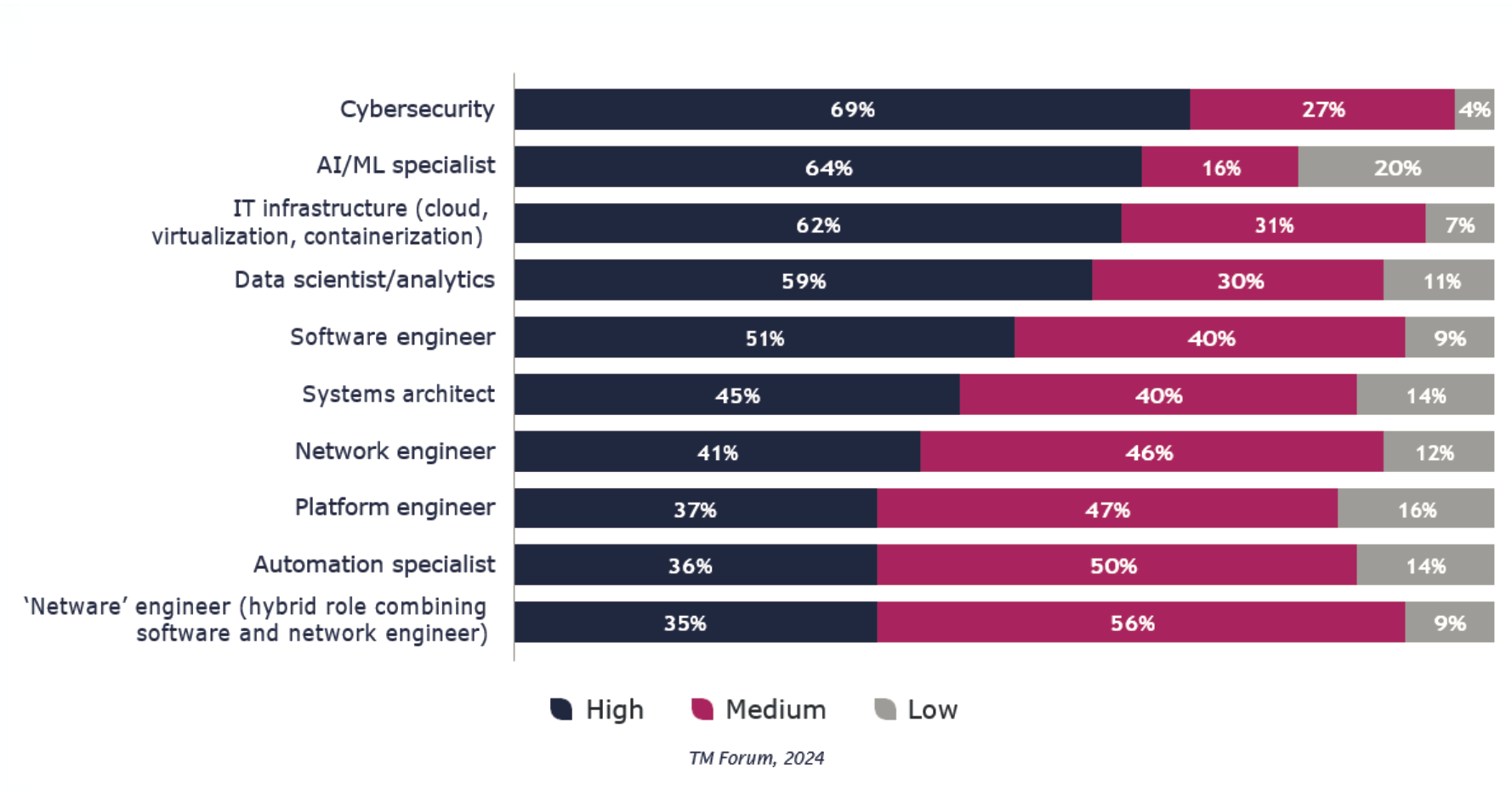
According to McKinsey & Company, GenAI is forcing operators to develop AI expertise internally while also requiring new skills from users, such as prompt engineering — the ability to ask questions to get the best response from LLM. Operators also need to hire data engineers and domain experts “who understand what data to collect and how to collect it, as well as monitoring and evaluating the quality of new types of data generated and used by GenAI systems . ”
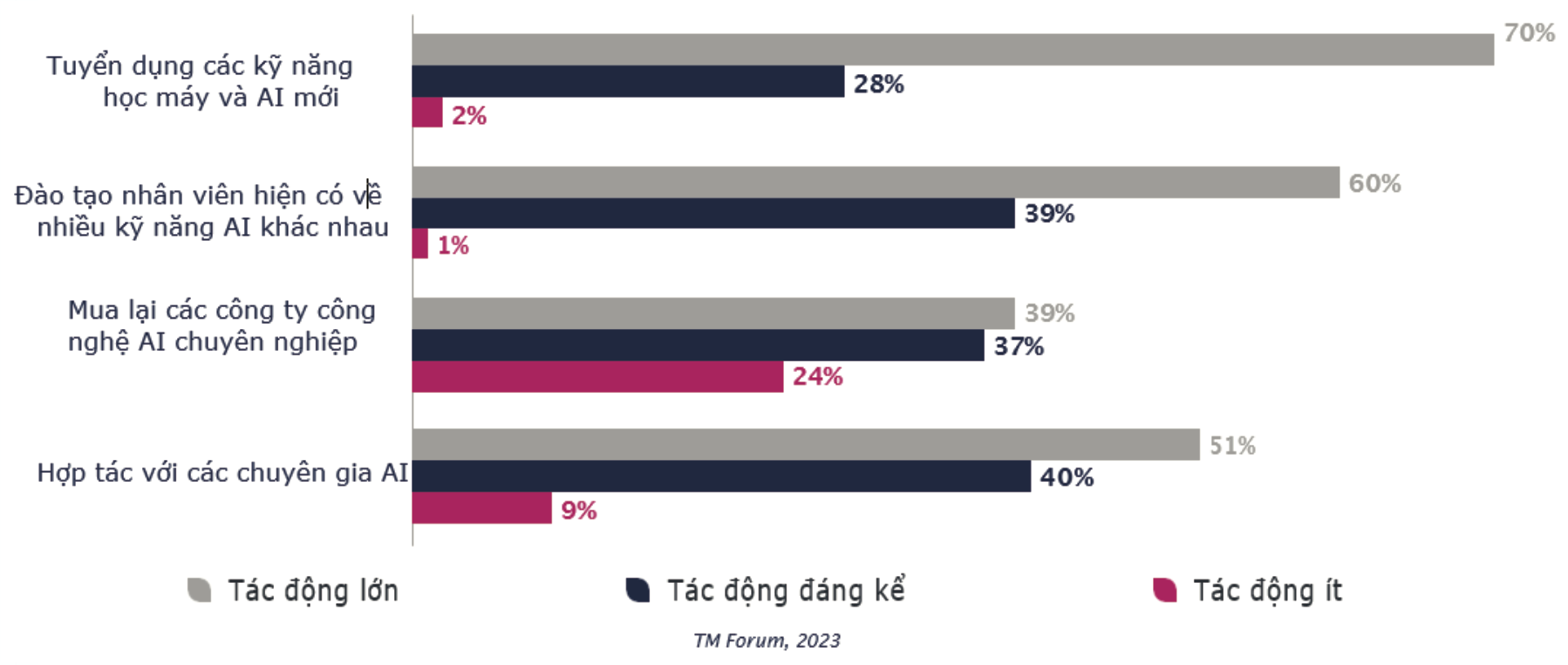
3.2. Data readiness for AI applications
A data-driven architecture is key to maintaining accuracy and consistency across the network. Using a common data model ensures data flows smoothly across all systems and is accurately served in all automated workflows.
AI needs data, and data analytics needs AI. Many operators today face significant challenges in developing coherent data strategies to fully exploit AI technology. Operators in the early stages of AI experimentation may underestimate what is needed, especially in terms of data, to successfully deploy AI at scale.
Many carriers lack a cohesive strategy that allows data to flow horizontally across the organization under a single data model.
Some specific challenges in getting data ready for AI:
There is a lack of clean, clear, consistent and actionable data that can be applied to different parts of the business from network to service delivery and customer experience. This is critical for all processes around data-driven, AI-driven execution.
Lack of a common data model (data is currently collected from multiple vendors) results in extremely time-consuming aggregation of structured and unstructured data.
Lack of data context, not knowing fully how, when, where and for what purposes the data is collected, is a particularly significant obstacle that Telcos must overcome if they want to deploy GenAI or any other type of machine learning model.
Operators are seeing the value of data and have been ramping up their investments in data analytics. Omdia estimates that global operators will invest $2.5 billion in data analytics by 2025.
In fact, the time and investment required to collect, clean, transform, and store data in the right format is often disproportionately higher than the time it takes to use that data. The process of creating data lakes and data warehouses has been going on for years, but it has yet to give carriers the ability to deploy AI at scale across their entire organization.
The advent of AI-based innovations and analytics has driven the need and demand for more diverse and flexible data usage, for example:
- AI/machine learning requires huge amounts of data to train models
- Diverse datasets and multiple data types are needed to ensure unbiased AI results
- Add data layers to improve model accuracy and application impact
- Models must be continuously trained with the latest information to maintain predictive performance, especially in dynamic environments
- Data must be available in real-time for critical business functions, primarily in highly interactive environments
- The advent of GenAI has given operators the opportunity to leverage the large amount of unstructured data that is available, but this data needs to be tagged and cleaned before being fed into LLM.
To make significant progress in AI from a data perspective, operators need to make a fundamental change in how they approach the data flowing through their systems, and sometimes a change in corporate culture. The key is to build a common data model and create a single source of truth.
Building a single source of truth is a hugely complex task that has so far been beyond the capabilities of most operators due to the fragmentation of their data. BT, Deutsche Telekom and Telefónica have taken steps to address this by moving all of their data to the public cloud. For example, over the past two years, BT has moved more than 90% of its data to the Google Cloud Platform.
AI Architecture, Build, Buy, and Scale
There are many similarities between AI/GenAi and cloud computing, notably the technological shift and the dominance of hypercallers. Carriers face the same problem, the same question as AI and Cloud: What to buy and what to build?
Carriers’ approach to AI is largely shaped by the core principles of open architecture and composability. Deutsche Telekom’s Omair Ahmed Khan says most of the company’s AI projects involve a combination of building and buying different components, “Deutsche Telekom has a hybrid strategy of building and buying, and the buying part has never involved buying a complete turnkey solution.”
Operators believe it is too early to consider AI as part of their enterprise architecture or as part of their reference architecture. Some operators with a clear vision and strategy for integrating AI into their future enterprise architecture also recognize implementation challenges specifically related to the people, tools, and capabilities needed to deliver effective results and a clear return on investment.
Software industrialization can be seen as a good practice for AI industrialization by moving data to public clouds and making data accessible in real time. A Southeast Asian carrier CIO described the process the company took to industrialize AI as a “data factory.” “This has significantly reduced the time and cost of AI production,” he said.
“Two years ago, the cost of AI production was very high. It took six to eight months to create an AI model. Now it takes just a few days. You can run the whole cycle much faster and with fewer people.”
Practice in some carriers:
China Mobile: has purchased hardware and built its own data center including graphics processing units (GPUs) and accelerators as part of the Jiutian LLM project.
Jio: Reliance Industries, the parent company of Indian telecom company Jio, has partnered with Nvidia to build supercomputing infrastructure for AI. Reliance aims to provide AI infrastructure to scientists, developers, and startups across India and create AI applications and services for Jio’s 450 million customers.
Deciding where to deploy AI in a public cloud or a private cloud is also a matter for telcos and largely depends on the scale of the deployment. Deploying AI in a public cloud has the advantage of abundant computing resources, power and specialized hardware needed to process complex algorithms and large amounts of data, however cost can become an issue if the operator only uses the public cloud to process large volumes of data.
The decision to use Private cloud for GenAI is considered by many operators to be unfeasible unless the operator is building its own LLM - such as the case of China Mobile, Softbank and SK Telecom in Asia and Deutsche Telekom in Europe. Operators tend to prioritize Public cloud for testing and building MVPs for AI use cases.
As carriers increase their use of AI, it will inevitably lead to deeper relationships.
- Softbank: has partnered with Nvidia to build data centers (TTDL) designed to host GenAI and wireless applications. The new TTDLs will handle both AI and 5G workloads.
- SK Telecom: is pursuing demand for AI-based data centers as part of SKT’s broader AI ambitions. CFO Yang-Seob Kim said SKT plans to “further boost its data center business, focusing on next-generation AI data centers and global expansion.”
- NTT is investing 1.5 trillion yen (about $12 billion) over the next five years to expand and upgrade its data center business globally to meet the growing demand for data usage related to the use of GenAI, along with other technologies.
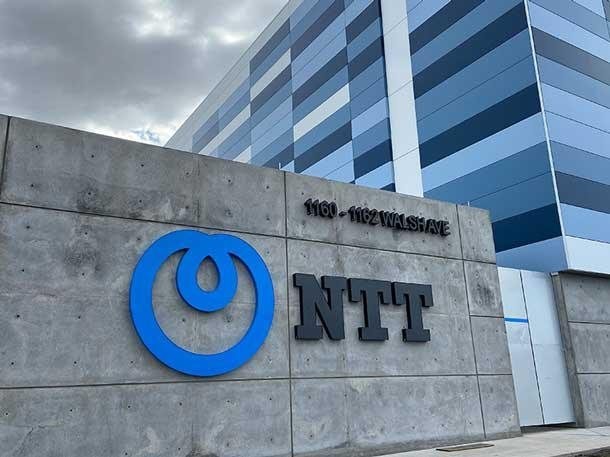
Deciding where to deploy AI in the public cloud or private cloud is also an issue for telcos and mainly depends on the scale of deployment. Deploying AI on the public cloud has the advantage of abundant computing resources, energy and specialized hardware needed to process complex algorithms and large amounts of data, but cost can become an issue if the network operator only uses the Public cloud to process large volumes of data.
The decision to use a private cloud for GenAI is considered by many carriers to be unfeasible unless the carrier is building its own LLM - such is the case with China Mobile, Softbank and SK Telecom in Asia and Deutsche Telekom in Europe. Network operators tend to prioritize Public cloud for testing and building MVPs for AI use cases.
As carriers increase their use of AI it will inevitably lead to deeper relationships with the super companies - Amazon Web Services, Microsoft Azure and Google Cloud.
References:
1.
Telecom Operations. https://www.ericsson.com/4ac6ca/
Assets/Local/Reports-Papers/Further-Insights/Doc/Ai-
business-potential.pdf
[2]. Emerging Tech Impact Radar: Artificial Intelligence, Gartner, 19 January 2024 ID G00796195
[3]. Generative Ai: Operators Take their first steps, Tmforum 2023
[4]. Building An Ai Strategy Telcos Put The Foundations in Place,
TMforum 3,2024
[5]. https://intellias.com/ai-in-telecommunications/
[6]. https://www.alliedmarketresearch.com/ai-in-
Telecommunication-Market-A09352
[7]. Gen Ai in Telecoms, Key Findds from Omdia's Genai Telco
Service Provider Survey Omdia 2024
[8] https://www.xenonstack.com/enterprise-generative-ai/
telecom/
[9]. Where is who heading? Nokia https://www.nokia.com/thought-
Leadership/Articles/AI/WHERE-IS-AI-SE-SE
[10]. Ericsson Telco Ai, Internal Document
(Article published in TT&TT Magazine, No. 8, August 2024)
Source: https://ictvietnam.vn/chien-luoc-ai-nao-cho-cac-nha-khai-thac-mang-vien-thong-66422.html




![[Photo] General Secretary To Lam receives Chairman of the National People's Congress of China Zhao Leji](https://vphoto.vietnam.vn/thumb/1200x675/vietnam/resource/IMAGE/2025/8/31/5af9b8d4ba2143348afe1c7ce6b7fa04)
![[Photo] National Assembly Chairman Tran Thanh Man welcomes and holds talks with Chairman of the National People's Congress of China Zhao Leji](https://vphoto.vietnam.vn/thumb/1200x675/vietnam/resource/IMAGE/2025/8/31/9fa5b4d3f67d450682c03d35cabba711)
![[Photo] Marching together in the hearts of the people](https://vphoto.vietnam.vn/thumb/1200x675/vietnam/resource/IMAGE/2025/8/31/8b778f9202e54a60919734e6f1d938c3)
![[Photo] The first meeting of the Cooperation Committee between the National Assembly of Vietnam and the National People's Congress of China](https://vphoto.vietnam.vn/thumb/1200x675/vietnam/resource/IMAGE/2025/8/31/f5ed4def2e8f48e1a69b31464d355e12)






















































































Comment (0)